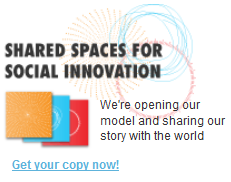I’m a fan of the Centre for Social Innovation in Toronto. It’s a dynamic model of collaboration for public good. We could use one like it, here in Victoria, for Southern Vancouver Island.
Last year, I wrote here about the Centre for Social Innovation (CSI), and their executive director, Ashoka Fellow Tonya Surman. (Ashoka Fellows are leading social entrepreneurs, recognized internationally for their innovative solutions to social problems; solutions that may potentially change patterns across society.)
Recently, CSI decided, in the spirit of generosity and open source, to share their business model with the world. Click here to get that model.
About the Centre for Social Innovation (CSI)
“Social Innovation refers to new ideas that resolve social, cultural, economic and environmental challenges for the benefit of people and planet. Even more simply, a social innovation is an idea that works for the public good.”
More than 100 organizations, projects and individual innovators, call CSI their permanent or part-time home. Here’s why:
- CSI builds on the theory that physical space is the foundation for community development and innovation.
- CSI is a hybrid of co-location, co-working, and incubator movements.
- Like co-locations, CSI provides permanent, stable office rental to organization. (Co-working is the sharing of workspace among freelancers and other independent workers)
- Like co-working spaces, CSI provides part-time hot desk spaces to independents. (Co-location is the sharing of spaces among a number of separate organizations)
- Like an incubator, CSI provides programming and shared services to its members, and offer a handful of projects support ranging from strategic advice to back-end financial services. (Incubators provide programmatic, strategic, administrative and/or financial support to small projects and organizations)
- CSI acts as a community hub, providing direct services to the geographic community in which it is situated.
- CSI members are selected based on their commitment to the goal of fostering social innovation.
- CSI programming is designed to increase the capacity of social enterprises, non-profits, charities, green businesses, artists, designers, creators, and activists to improve the well-being of people and our planet.
- A focus on small. CSI is oriented to groups with five or fewer staff (folks who are often working out of their basement or home/office). The vast majority of members are one- and two-person operations. It is these small groups that are in the greatest need of shared facilities and administration; it is also these groups that are best positioned to collaborate and connect with others. (
- Emphasis on physical design. CSI understands the critical role of physical design in setting the tone of a space and the behaviour of its users; “creating the spaces where change happens”.
- “Animation as practice”. Community animation is a concept that CSI uses to communicate what turns a place to work, to a space of social innovation. CSI is building the practice of animation, and developing its role, as a central feature of successful shared spaces.
As a further intro to CSI, watch this video interview of Tonya Surman, CSI’s executive director and co-founder.
How about a CSI in Victoria?
Victoria and Southern Vancouver Island has its own social challenges; e.g., homelessness and food security.
Why not benefit from this region’s abundant supply of social entrepreneurs? What if we had our own Centre for Social Innovation here? A space where social entrepreneurs come together, collaborate, and create innovative solutions to social problems.
Let’s work together and make this happen. I’m in. How about you?
If you enjoyed this post, please consider leaving a comment or subscribing to my blog. Thanks, Ben.


From this definition – “a social innovation is an idea that works for the public good – that’s what every civil servant is paid to dream up every day. After lots of years in the BC government, I would say that we have a lot of forward-thinking employees who make it a Social Innovation Centre. Not every one, but enough.
With a bit of support from politicians open to logic and innovation (certainly excludes Stephen Harper) governments do this all the time. It’s probably quicker and easier to see at the municipal level.
Hi Bruce. Thanks for your thoughts around each civil servant as part of a large CSI. If long-term is the only perspective for judging innovation (which I believe), then delivering new solutions that last (putting ideas to work) is imperative. Ideas are plentiful. Shipped solutions/innovations less so. One of the unique aspects of the CSI in Toronto is that the people bringing ideas to market (innovation for public good) are largely social entrepreneurs of 5 people or less. I wonder how governments can leverage the small group dynamic more?